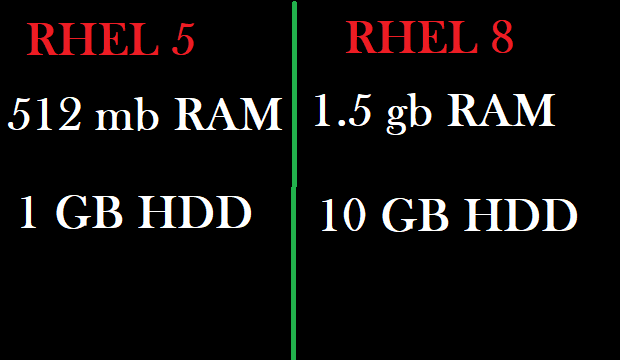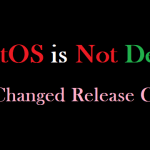RHEL 5 To RHEL 8 Minimum Requirement and Maximum Limit of Hardware
In this article, we will talk about the minimum requirement and maximum limit of our production favorite OS in maximum datacenters. For any system admin, these are the most important things when they working in any production environment where any amount of resource can generate revenue.
As we all know who work in Linux system in any production environment, the common issue we face is system load. So before designing any solution for production we have to know about hardware requirements for OS and their applications.
The minimum requirement will help us in stating a project that minimum cost to start a project because there will be no revenue generated from a new project.
The maximum limit helps us to forecast for new hardware and cluster which help the production environment to run smoothly.
Maximum logical CPUs
| Architecture |
RHEL 5 |
RHEL 6 |
RHEL 7 |
RHEL 8 |
| x86 |
32 |
32 |
Not Applicable |
Not Applicable |
| Itanium 2 |
256 [1024] |
Not Applicable |
Not Applicable |
Not Applicable |
| x86_64 |
160 [255] |
448 [4096]13 |
768 |
768 [8192] |
| POWER |
128 |
128 |
768 |
POWER8: 768 |
| |
|
|
|
POWER9: 1536 |
| System z |
64 (z13) |
64 (z13) |
256 (z13) |
340 (z14) |
| ARM |
N/A |
N/A |
N/A |
256 |
Minimum logical CPUs
We can use 2 CPU for any RHEl version OS installation
Maximum memory
| Architecture |
RHEL 5 |
RHEL 6 |
RHEL 7 |
RHEL 8 |
| x86 |
16GB2 |
16GB2 |
Not Applicable |
Not Applicable |
| Itanium 2 |
2TB |
Not Applicable |
Not Applicable |
Not Applicable |
| x86_64 |
1TB |
12TB [64TB] |
12TB [64TB] |
24TB [64TB] |
| POWER |
512GB [1TB] |
2TB |
32TB17 |
POWER8: 32TB [128TB] |
| |
|
|
|
POWER9: 64TB [128TB] |
| System z |
4TB (z13) |
4TB (z13) |
10TB (z13) |
16TB (z14) |
| ARM |
N/A |
N/A |
N/A |
1.5TB [256TB] |
| Maximum x86 per-process virtual address space |
Approx. 3GB2 |
Approx. 3GB |
Not Applicable |
Not Applicable |
| Maximum x86_64 per-process virtual address space |
2TB |
128TB |
128TB |
128TB |
| Maximum POWER per-process virtual address space |
|
|
|
4PB19 |
Minimum Required Memory
| Architecture |
RHEL 5 |
RHEL 6 |
RHEL 7 |
RHEL 8 |
| x86 |
512MB minimum, 1 GB per logical CPU recommended |
512MB minimum, 1 GB per logical CPU recommended |
Not Applicable |
Not Applicable |
| Itanium 2 |
512MB, 1 GB per logical CPU recommended |
Not Applicable |
Not Applicable |
Not Applicable |
| x86_64 |
512MB minimum, 1 GB per logical CPU recommended |
1GB minimum, 1 GB per logical CPU recommended |
1GB minimum, 1 GB per logical CPU recommended18 |
1.5GB minimum, 1.5GB per logical CPU recommended18 |
| POWER |
1GB minimum, 2GB recommended |
2GB minimum, 2GB required per install |
2GB minimum, 2GB required per install |
2GB minimum, 2GB required per install |
| System z |
512MB |
512MB |
1GB |
1GB minimum, 2GB required for installation |
| ARM |
N/A |
N/A |
N/A |
2GB |
Minimum Required Disk Space
| RHEL 3 |
RHEL 6 |
RHEL 7 |
RHEL 8 |
| 800MB |
1GB minimum, 5GB recommended |
10GB minimum, 20GB recommended |
10GB minimum, 20GB recommended |
File Systems And Storage Limits
| Ext3 |
|
|
|
|
| |
|
|
|
|
| Feature |
RHEL 5 |
RHEL 6 |
RHEL 7 |
RHEL 8 |
| Maximum file size |
2TB |
2TB |
2TB |
2TB |
| Maximum file system size |
16TB |
16TB |
16TB |
16TB |
| Maximum subdirectories |
32000 |
32000 |
32000 |
32000 |
| Maximum symlink depth |
8 |
8 |
8 |
8 |
| ACL support |
Yes |
Yes |
Yes |
Yes |
| |
|
|
|
|
| Ext4 |
|
|
|
|
| |
|
|
|
|
| Feature |
RHEL 5 |
RHEL 6 |
RHEL 7 |
RHEL 8 |
| Maximum file size |
16TB |
16TB |
16TB |
16TB |
| Maximum file system size |
16TB [1EB] |
16TB [1EB] |
50TB [1EB] |
50TB [1EB] |
| Maximum subdirectories |
65000/unlimited |
65000/unlimited |
65000/unlimited |
65000/unlimited |
| Maximum symlink depth |
8 |
8 |
8 |
8 |
| ACL support |
Yes |
Yes |
Yes |
Yes |
| |
|
|
|
|
| GFS |
|
|
|
|
| |
|
|
|
|
| Feature |
RHEL 5 |
RHEL 6 |
RHEL 7 |
RHEL 8 |
| Maximum file size |
16TB [8EB]4 |
N/A |
N/A |
N/A |
| Maximum file system size |
16TB [8EB]4 |
N/A |
N/A |
N/A |
| Maximum subdirectories |
unlimited |
— |
— |
— |
| Maximum symlink depth |
unlimited |
— |
— |
— |
| ACL support |
Yes |
— |
— |
— |
| |
|
|
|
|
| GFS2 |
|
|
|
|
| |
|
|
|
|
| Feature |
RHEL 5 |
RHEL 6 |
RHEL 7 |
RHEL 8 |
| Maximum file size |
100TB [8EB] |
100TB [8EB] |
100TB [8EB] |
100TB [8EB] |
| Maximum file system size |
100TB [8EB] |
100TB [8EB] |
100TB [8EB] |
100TB [8EB] |
| Maximum subdirectories |
— |
unlimited |
unlimited |
unlimited |
| Maximum symlink depth |
— |
unlimited |
unlimited |
unlimited |
| ACL support |
— |
Yes |
Yes |
Yes |
| |
|
|
|
|
| XFS |
|
|
|
|
| |
|
|
|
|
| Feature |
RHEL 5 |
RHEL 6 |
RHEL 7 |
RHEL 8 |
| Maximum file size |
100TB [8EB] |
100TB [8EB] |
500TB [8EB] |
8EB |
| Maximum file system size |
100TB [16EB] |
300TB [16EB]15 |
500TB [16EB] |
1PB |
| Maximum subdirectories |
unlimited |
unlimited |
unlimited |
unlimited |
| Maximum symlink depth |
8 |
8 |
8 |
8 |
| ACL support |
Yes |
Yes |
Yes |
Yes |
Storage
| Feature |
RHEL 5 |
RHEL 6 |
RHEL 7 |
RHEL 8 |
| Maximum Boot LUN size (BIOS) |
2TB |
2TB |
2TB |
2TB |
| Maximum Boot LUN size (UEFI) |
N/A |
32bit (i686) – 2TB |
50TB |
8EB |
| |
|
64bit – 16TB (tested limit) |
|
|
| Maximum number of device paths (SDX devices) |
1,024 |
8,192 |
10,000 |
10,000 |
These requirements are at the time of article. As per our experience, only RHEL 8 requirement will change because RHEL8 is still in development mode.
Hope this article will help you and your company solution architect to design an optimal solution for customers. If you are going to startup with RHEL os then you know how much minimum required hardware you need to purchase for your production and testing.
Sharing is Caring


